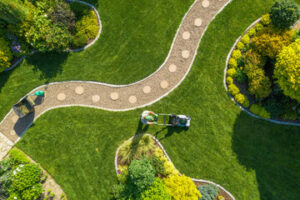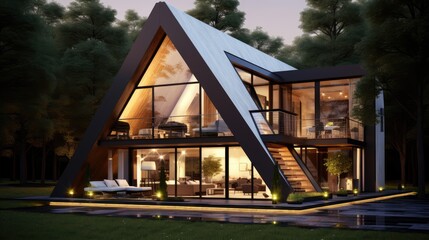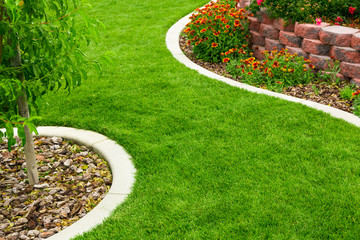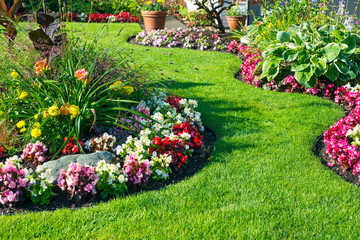Why Landscaping Is Important to the Health of Your Family, Community, and Environment
Landscaping improves the health of your family, community, and environment. Grass and trees cool temperatures, remove carbon dioxide, produce oxygen, and capture dust, smoke, and other pollutants.

Landscapes also protect homes from erosion and flooding. They also reduce energy consumption through outdoor lighting and heating/cooling systems. Well-maintained landscaping increases curb appeal and helps sell a home faster. Contact Prime Cut Lawn and Landscaping for professional help.
Color has a powerful impact on the way that we perceive landscapes. It can create specific moods and emotions, so it is important to understand how to use this element when designing your landscape. Warm colors can create a vibrant and energetic atmosphere, while cool colors can promote a sense of tranquility and relaxation.
Using the right colors in your landscape can also help to define spaces and elements. For example, using contrasting colors can make pathways or seating areas stand out against the surrounding landscape, and it can also be used to draw attention to focal points such as statues, fountains, or plants. In addition, using seasonal colors can create an immersive and emotionally captivating experience throughout the year.
Complementary Colors
Choosing complementary colors in your landscape can create high-contrast and eye-catching combinations. For example, red flowers or foliage against a backdrop of green grass can create a striking and dynamic visual display. Alternatively, you can experiment with different shades and tones of one color to create subtle variations in your landscape design.
Analogous Colors
Unlike complements, analogous colors are adjacent to each other on the color wheel and blend well together. For example, yellow, yellow-green, and green; red, red-orange, orange, and blue are all analogous colors that work well together and create a natural sense of harmony and balance in your landscape. You can also try mixing primary colors to create secondary hues, such as yellow-purple or blue-green.
Warm and Cool Colors
While complementary colors offer a high-contrast effect, it is important to balance them with other colors in your landscape design to maintain balance and harmony. For example, pairing purple flowers or foliage with vibrant yellow accents or foliage can add a bold and visually interesting touch to your landscape.
Using a monochromatic color scheme can create a sense of unity and cohesion in your landscape design by focusing on variations of a single color. This can be a great option for those looking to achieve a more refined and sophisticated aesthetic in their landscape design. In addition, monochromatic colors can highlight the textures and shapes of different plants, structures, and objects by eliminating the distraction of contrasting colors.
Form
The form of a landscape is how the plants and structures are shaped. It’s important to choose shapes that complement each other and are proportional. This helps create unity within the design and keeps it looking balanced once it’s completed. Some examples of form include rectilinear shapes (houses, sidewalks, driveways) and plant/shrub shapes that feel structured and formal, circles or irregular shapes that give off more of a casual look, and drooping or weeping forms that add a natural element to the design.
Line is a very important aspect of form because it determines how the eye moves through a space. Straight lines with hard angles tend to feel structural and forceful, are associated with a formal character, and lead the eye directly to a focal point. Curved lines are more fluid and natural, they are associated with a relaxed and informal character, and they allow the eye to move at a slower pace and discover hidden views.
Landscape theme is a large component of form because it dictates how the landscape is designed and what kinds of forms are used. A more formal garden will likely use forms like clipped hedges, while a more natural garden can use organic lines and meandering curves.
Composition
A beautiful landscape isn’t just about flowers and plants, but how these features are arranged to create a visual balance. There are a few basic principles to landscape composition, including proportion, order, repetition and unity. By using these rules, you can create a balanced and attractive landscape for your home or business.
The first rule of landscape composition is to establish a strong point of interest. This can be a tree, plant or other natural feature in the foreground, middle ground or background. Foreground elements are particularly important, as they can help to frame and focus attention on your main subject. Varying your perspective is also an effective way to strengthen a landscape image.
The next rule of landscape composition is to use line, form and color to create a rhythm or pattern in the scene. This can be achieved by using elements like sweeping curves, the banks of rivers and breaking waves or geometric forms such as triangles formed by trees, boulders and ridges. It’s important to remember that too much repetition can lead to monotony, so it is best used sparingly.
Another important consideration in landscape composition is establishing a sense of balance and harmony. This can be achieved by balancing the different elements of the scene, such as color, texture and shape. It is also important to consider the overall scale of the landscape. If you have a small garden, it is best to stick to a simple design so that the space doesn’t become overwhelmed.
In addition to defining the landscape, hardscape elements such as patios, walkways and retaining walls can provide functionality and structure to a property. By using these materials, you can create outdoor living spaces and control erosion on your property.
Landscaping is a broad term that encompasses a wide range of services, from planting shrubs and trees to mowing lawns. It is a critical part of any property’s aesthetics and function, and can enhance the value and beauty of your home or business. The right landscaping can also make your home more energy efficient and improve its environmental footprint.
Lighting
A house’s yard and garden are often a big investment of time and money. But why enjoy these beautiful features only during the day? Landscape lighting is the perfect way to extend the beauty of your property into the dark hours. It will allow you to fully appreciate your hard work and accentuate any architectural or aesthetic elements.
Creating the right effect with lighting is key, and there are many techniques that can be used to achieve your desired look. One popular technique is up-lighting, where a light is positioned at the top of an object, such as a statue or tree, to cast a shadow down its side. This creates a dramatic and eye-catching effect that highlights the shape and texture of the object. Another effect that’s popular is washing, where a light is positioned at ground level to produce a soft and diffused glow over an area.
There are also many practical uses for landscape lighting. For example, path lights are an excellent way to illuminate walkways, driveways and other areas where people tend to stumble or trip. This can help prevent accidents and injuries from occurring at night. In addition, landscape lighting can be used to highlight safety-related features of a garden, such as stairs and uneven surfaces. This can help deter crime by making it more difficult for burglars to see where they’re going.
Another benefit of landscape lighting is its versatility. It can be added to a garden in stages, allowing homeowners to gradually add it over time as they have the budget and time to do so. This makes it a good option for those who want to improve the look of their home without committing to a large-scale project.
Finally, landscape lighting can help increase the resale value of a property by improving its curb appeal. A well-lit garden or courtyard can be a great selling point, and it will make potential buyers feel at home from the moment they step out of their car. It can also be a great way to impress guests at a dinner party or family gathering, highlighting any decorative or functional elements of the garden.




